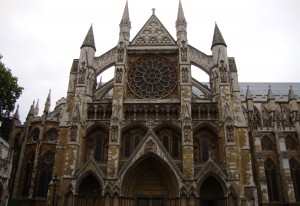
Westminster Abbey
Yesterday, I stood on Charles Darwin’s grave. And no, it was not in a cemetery or science sanctuary, it was in a church. Over 3,000 people are buried at Westminster Abbey. While it is mainly dominated by various royal figures, there are several burials and memorials for literary figures, scientists, and even an unknown soldier. But by far the most shocking person buried there is Charles Darwin. Despite the fact that in many ways his work refutes the teachings of the church, he is still honored there as an important historical figure. This illustrates the importance of English history to the English, to the point where they would rather honor a historical figure who they disgraced with than have his part of history lost.
As an English major, there was also another part of the church I particularly liked: poet’s corner. There I saw stones for many writers including D. H. Lawrence, Lewis Carroll, and Dylan Thomas. However, I was disappointed to realize that not everyone who had a stone on the ground was really buried there. I later learned that these stones served mainly as memorials to recognize these artists’ efforts. One the bright side, I did stand on Charles Dickens, who is actually buried in the church next to Rudyard Kipling.
All these sanctuaries, memorials, and graves, some with carving or detailed sculptures of the deceased present set me thinking about death rituals. The more we looked at these secularized burial spots , the more they began to resemble the Egyptian burial traditions. My knowledge of their practices is limited, but to my understand the Egyptians bury their dead in elaborate tombs with gold and riches to prepare them for the afterlife. And I looked at the extravagant sculpture of Queen Elizabeth lying about her body I began to wonder what the purpose of this whole thing was. Who was really being honored here? Queen Elizabeth? The artist? The patron or surviving family members? Or even the church itself?
And amongst these thoughts, as I walked the tours, the announcement came on for a moment of prayer, it was 11:00. And out of these thoughts of vain royalty, religious celebrations, or tourist attractions, I was reminded that we were in a place of worship, a house of God. And these people were lying here to be with God and to be remembered. These ornate carving and statues were not meant to honor the person, to prepare them for the afterlife, or even to make Westminster Abbey the tourist attraction that it is today; they were made to honor England’s history. Everyday people visit Westminster Abbey and they worship this country’s history.
To view a slideshow of photos from my time at Westminster Abbey, The National Gallery, and the South Bank please click here.

1 response so far ↓
anyasettle // Aug 30th 2009 at 17:51
Nice post, Megan! Great point about Charles Darwin. That struck me as being interesting, too, especially the fact that tomb of Sir Isaac Newton can be found within the Abbey as well, who contributed equally to the world of science, I feel. I really liked hearing the tour guide, John, explain Newton’s views on faith and science, which was something along the lines of: “The laws of physics govern the movement of the planets, but only God could have set them in motion.” It is interesting how he was able to marry science and religion in his faith.
You must log in to post a comment.